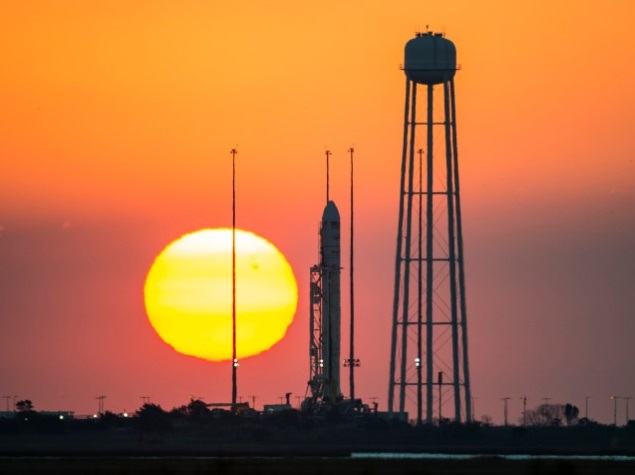- Home
- Science
- Science News
- Mars 2 Mission to Launch in 2018, Says Isro
Mars-2 Mission to Launch in 2018, Says Isro

"We plan to launch a second mission to Mars in 2018, probably with a lander and rover, to conduct more experiments for which we have to develop new technologies," Indian Space Research Organisation (Isro) satellite centre director S. Shiva Kumar told reporters in Bangalore.
The state-run space agency successfully inserted its spacecraft (MOM) September 24 in the Martian orbit with five scientific instruments to search for life-sustaining elements on the planet over nine months after it was launched November 5, 2013 from its spaceport at Sriharikota in Andhra Pradesh and about 90 km northeast of Chennai.
"We will be able to take the Mars-2 mission after launching the second mission to the moon (Chandrayaan-2) in 2016 with our own lander and rover, which will help us develop a separate lander and rover for the red planet," Kumar said, ahead of a three-day 'Engineers Conclave-2014' by the space agency with the Indian National Academy of Engineering in Bangalore.
As missions to Mars can be launched only at an interval of two years, the space agency is looking for a slot in 2018 and by which it hopes to have a heavy rocket fully operational to carry a lander and rover with scientific experiments as additional payloads.
"We hope to have fully operational heavy rockets over the next two-three years for carrying communication satellites weighting two-three tonnes into the geo-stationary orbits around the earth," Kumar said.
The space agency has developed the geo-synchronous satellite launch vehicle (GSLV-Mark I-III) with indigenous cryogenic engine to launch heavier satellites weighing more than two tonnes and three tonnes into the geo-orbit at 36,000 km above Earth.
"GSLV-Mark I-III will be used for Chandrayaan-2, which will have heavier payload than its predecessor (Chandrayaan-1) and later for Mars-2 mission, as both will have a lander and rover in addition to scientific experiments," he said.
The space agency launched January 5 a GSLV rocket with an indigenous cryogenic engine from the spaceport and placed a communication satellite (Gsat-14) in the geo-stationary orbit.
Chandrayaan-1 was launched October 22, 2008, using a polar satellite launch vehicle (PSLV-C11), a four-stage rocket.
The 475 kg Mars Orbiter was also launched onboard a polar rocket.
The GSLV-Mark III's maiden launch is likely to be in December.
For the latest tech news and reviews, follow Gadgets 360 on X, Facebook, WhatsApp, Threads and Google News. For the latest videos on gadgets and tech, subscribe to our YouTube channel. If you want to know everything about top influencers, follow our in-house Who'sThat360 on Instagram and YouTube.
Related Stories
- Samsung Galaxy Unpacked 2025
- ChatGPT
- Redmi Note 14 Pro+
- iPhone 16
- Apple Vision Pro
- Oneplus 12
- OnePlus Nord CE 3 Lite 5G
- iPhone 13
- Xiaomi 14 Pro
- Oppo Find N3
- Tecno Spark Go (2023)
- Realme V30
- Best Phones Under 25000
- Samsung Galaxy S24 Series
- Cryptocurrency
- iQoo 12
- Samsung Galaxy S24 Ultra
- Giottus
- Samsung Galaxy Z Flip 5
- Apple 'Scary Fast'
- Housefull 5
- GoPro Hero 12 Black Review
- Invincible Season 2
- JioGlass
- HD Ready TV
- Laptop Under 50000
- Smartwatch Under 10000
- Latest Mobile Phones
- Compare Phones
- Realme Neo 7 SE
- Realme Neo 7x
- Oppo Find N5
- Apple iPhone 16e
- Samsung Galaxy A06 5G
- Realme P3 Pro 5G
- Realme P3x 5G
- Vivo V50
- MSI Vector 16 HX AI
- MSI Raider 18 HX AI
- Asus ROG Flow Z13 (2025)
- Xiaomi Pad 7
- boAt Ultima Prime
- boAt Ultima Ember
- Haier M95E
- Sony 65 Inches Ultra HD (4K) LED Smart TV (KD-65X74L)
- Sony PlayStation 5 Pro
- Sony PlayStation 5 Slim Digital Edition
- Blue Star 1.5 Ton 3 Star Inverter Split AC (IC318DNUHC)
- Blue Star 1.5 Ton 3 Star Inverter Split AC (IA318VKU)
















